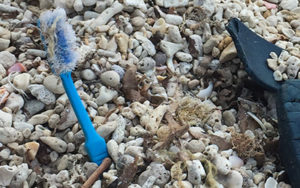
11 March 2016
This is the second newsletter in a series of three on plastics. In the previous newsletter, we looked at the amount and source of plastics and where it goes. Now we will look at why plastics are a problem.
How Long Does It Last?
Plastics are now found everywhere in the marine environment. Even worse, they last a very long time. Traditional, natural materials breakdown in weeks or months. Plastic materials last for years, sometimes hundreds of years. When materials like plastic sacks “breakdown,” they only become smaller pieces of plastic. A few examples of the necessary breakdown times are as follows:
- Toilet paper – 2 to 4 weeks
- Newspaper – 6 weeks
- Natural rope – 3 to 14 months
- Aluminum can – 200 to 500 years
- Plastic bottle – 100 to 1000 years
- Disposable diaper – 400 to 450 years
- Plastic fishing line and net – 600 years
That means a toothbrush will still look like a toothbrush after hundreds of years.
Why Does It Matter?
The impacts on animals in the marine environment are serious and growing. In 2002, researchers found reports of 260 different species that were impacted by litter. By 2014, 693 species were reported as having died from eating plastic materials or being entangled in them. That number continues to grow.
Lost or abandoned fishing gear has the greatest impact on marine life. Next are plastic bags, plastic utensils, and balloons.
While many people are aware of the risk of plastics to turtles or dolphins, sea birds are very heavily impacted. In a study in Europe’s North Sea area, 95% of northern fulmar birds had plastic in their digestive systems. The only birds without plastic in their systems were in remote areas of the arctic.
Under the water, plastic bags and abandoned fishing lines wrap around the corals on the reefs smothering them and breaking them. Fish and other marine creatures eat drifting plastic particles.
Over time, plastics sink to the ocean floor, and we do not know what their impact is.
Unfortunately, it seems that human beings only react when a problem affects them personally. So researchers and communications specialists are trying to make the link back to economics and human health.
On the economic side, trash covered beaches and water reduce revenues because tourists avoid resorts, water sports activities, and fishing in impacted areas. Floating plastics get twisted around propellers, damaging boat motors and causing problems for local fishermen, dive operators, and other marine businesses.
Large floating masses of trash are now crossing oceans carrying invasive species. The risk to human health is increasing because viruses and insects can survive for a long time on these floating islands.
Plastics also attract other chemical pollutants in the water such as pesticides and oil-related chemicals. These pollutants stick to the plastics and increase their toxicity. Now researchers are studying fish to see if the toxic pollutants on the plastics they eat are absorbed into their bodies. If so, that could impact humans who eat the fish as well as the rest of the ocean food chain.
What Can We Do?
Start with Refuse, Reduce, Reuse, Recycle. Actions can be implemented at an individual level, an organizational level like schools and businesses, and at a policy level.
REFUSE is the most important because it prevents plastics, especially single-use plastics, from becoming part of the waste cycle. It is an action you can take yourself. It is an action you can educate and encourage others to take. It is a policy that can be put into place at local and national levels. Some examples include not buying, or better yet, banning:
- Cosmetic products with microbeads and other microplastics,
- Single-use plastic bags,
- Balloons,
- Plastic straws and stir sticks.
REDUCE the use of plastics to keep the problem from getting bigger. Examples include: Using refillable water bottles and coffee cups, Choosing natural materials instead of plastics.
REUSE plastic materials. Find solutions to give plastic materials another life.
RECYCLE whenever possible. But beware – recycling is not the complete solution to the plastics problem. Recycled plastics are lower in quality, and they are used in lower-value applications than their original use.
In Europe, with a high level of collection, regulation, and incentives, only 29% of plastics are recycled. In the United States, only about 8% of plastics are recycled. High-value plastics such as PET (ex: water bottles) and HDPE (ex: milk & shampoo bottles) are more likely to be separated from waste and recycled. Low-value plastics such as LDPE (ex: plastic sacks) are either incinerated to generate energy or go to landfills.
In many parts of the world, waste collection is low and recycling systems do not exist. In the next newsletter, we will look at efforts to improve collection in 5 key countries and innovative solutions to collect plastic already in the water.
